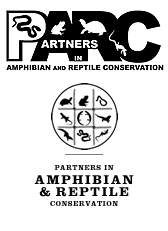 |
Alabama
Chapter of Partners in  Amphibian and
Reptile Conservation
Amphibian and
Reptile Conservation
 |
 |
Sampling Tools
What tools are being used?
The Alabama Amphibian Network uses two tools used by practicing herpetologists in the field to sample amphibians: coverboards and PVC “treefrog shelters.” Coverboards are simply a piece of plywood, lumber, or other material laid flush to ground level and often covered with leaf litter. These boards mimic the rotting logs and downed trees used by many amphibians as habitat by holding moisture and moderating temperatures, allowing researchers to observe and study amphibians simply by lifting the boards and documenting what lies beneath. Coverboard arrays being used in the Alabama Amphibian Network are composed of twenty 2 x 4-foot plywood coverboards.
PVC treefrog shelters are simply lengths of PVC pipe hung vertically from a standing tree and capped at the lower end to retain moisture. Treefrog shelters act similar to coverboards by mimicking refugia used by treefrog species in standing or standing dead trees. Researchers can simply look inside treefrog shelters and document what species may be using them as shelter. The treefrog shelters in the Alabama Amphibian Network are composed of ten 2-foot by 1.5-inch lengths of PVC pipe hung vertically from trees at each site. These shelters have also been outfitted with a length of “escape rope” to help flying squirrels who sometimes unwittingly find their way inside.
Why use coverboards?Coverboards and treefrog shelters are both “passive” types of sampling tools, meaning that animals using them are simply viewing the tools as habitat and won’t become trapped inside, as occurs with other tools often used by herpetologists. This low-maintenance approach to sampling suits environmental education centers, which occasionally go long periods without an educational group present. The sampling tools used in the amphibian network are also easy to use, allowing students of all ages to take part in educational programs using these tools and get involved in actual scientific research.
What benefits will the network have?The Alabama Amphibian Network is aimed at bridging two knowledge gaps that hamper amphibian conservation in Alabama: a lack of public awareness and a poor understanding of species distributions and population trends. The network approaches this first issue, a lack of public awareness, by exposing students and citizens to hands-on encounters with Alabama’s amphibian diversity and directly involving them in scientific research. This serves to both increase a general appreciation of biodiversity in the public eye and to increase scientific literacy among our state’s citizenry.
The second issue, a poor understanding of species distributions/population trends, is a problem faced by the scientific community. Despite having some of our nation’s highest levels of amphibian diversity, Alabama also suffers from a lack of basic data that scientists can use to guide amphibian conservation. With amphibians declining both in our state and worldwide, providing this data is an important first step towards conservation efforts. The network approaches this issue by allowing EE centers to serve as long-term monitoring stations for amphibian populations. The species encountered at each center will be used to update species’ ranges in Alabama, and over the long term, keep track of how amphibian populations are doing. Thus, the network’s benefits are two-fold: EE centers get a valuable educational tool, and scientists get valuable data on Alabama’s amphibians.
Return to Alabama Amphibian Network
Visit our parent organizations:
© 2009-2012 Alabama Partners in Amphibian and Reptile
Conservation
This website and any products posted herein are officially
recognized
by the national entity,
Partners in Amphibian and Reptile Conservation
(PARC), as the efforts of an approved PARC state chapter.


